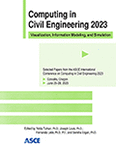Emerging Technologies in Interactive Workspaces: A Framework for Architecture, Engineering, and Construction Use Cases
Publication: Computing in Civil Engineering 2023
ABSTRACT
The study shows the relationship between the AEC use case purposes, goals, and collaborative technologies in interactive workspaces (IWs). The new Human/Buildings Simulation, Integration, Visualization, and Automation Laboratory (H/B-SIVA Lab) at the University of Nebraska–Lincoln (UNL), which incorporates hardware, software, inputs, and outputs systems such as multimodal devices, wireless devices, and large displays, was used as an illustration. The study is still in progress, and local AEC researchers and professionals will be consulted on its validity in the future. It covers the attributes and benefits of IWs, the H/B-SIVA Lab, IWs use cases and task types, IWs emerging technologies, the proposed IWs framework, and the conclusion and future research. This study provides a standard language and structure for determining appropriate methods to enhance the adoption and successful adoption of IWs technologies and the use cases in collaborative project teams in the AEC industry for AEC researchers and professionals.
Get full access to this article
View all available purchase options and get full access to this chapter.
REFERENCES
Borchers, J. (2006). The Aachen media space: Multiple displays in collaborative interactive environments. In Workshop Information Visualization and Interaction Techniques for Collaboration across Multiple Displays in conjunction with CHI.
Castronovo, F., Silva, M. B., Ventura, S. M., and Akhavian, R. (2019). A first step in generating a decision-making framework for the development of interactive workspaces. In Computing in civil engineering 2019: Visualization, information modeling, and simulation, American Society of Civil Engineers, Reston, VA, 39–47.
Frost and Sullivan. (2012). Selection and use of collaboration tool to maximize team performance.
Fruchter, R. (2008). Degrees of engagement in interactive workspaces. In Cognition, communication, and interaction. Springer, London. 56–69.
Heeramun, P., Nikolic, D., and Harty, C. (2015). Technology-enabled collaborative spaces for design and construction reviews.
Issa, M. H., Rankin, J. H., and Christian, A. J. (2006). A framework to assess the collaborative decision-making process in interactive workspaces. In Joint International Conference on Computing and Decision Making in Civil and Building Engineering.
Johanson, B., and Fox, A. (2002). The event heap: A coordination infrastructure for interactive workspaces. In Proceedings fourth IEEE workshop on mobile computing systems and applications. 83–93.
Johanson, B., and Fox, A. (2004). Extending tuplespaces for coordination in interactive workspaces. Journal of Systems and Software, 69(3), 243–266.
Lahlou, S., ed. (2009). Designing user-friendly augmented work environments. Springer Verlag London.
Lather, J. I. (2016). An ontology for interactive workspaces and their use cases within collaborative design and construction practices. MSc. thesis, Pennsylvania State Univ., University Park, PA.
Lather, J., Leicht, R., and Messner, J. (2018). Engaging with BIM: Interactive workspaces in facility design and construction. In Construction Research Congress 2018. 765–775.
Leicht, R. M., Messner, J. I., and Poerschke, U. (2014). INVOLVE: Developing interactive workspaces that impact communication and task performance when using virtual prototypes. Journal of Computing in Civil Engineering, 28(2), 91–201.
Rankin, J., Issa, M., and Christian, A. J. (2006). “Exploring the principles of interactive collaborative workspaces,” CSCE, 1st International Construction Speciality Conference, submitted for review.
Román, M., Hess, C., Cerqueira, R., Ranganat, A., Campbell, R. H., and Nahrstedt, K. (2002). Gaia: A Middleware Infrastructure to Enable Active Spaces Revised Paper# 20 (2nd Revision).
Sousa, J. P., and Garlan, D. (2002). Aura: an architectural framework for user mobility in ubiquitous computing environments. In Working Conference on Software Architecture. Springer, Boston, MA. 29–43.
Su, R. E., and Bailey, B. P. (2005). Put them where? towards guidelines for positioning large displays in interactive workspaces. In IFIP Conference on Human-Computer Interaction. Springer, Berlin, Heidelberg. 337–349.
Zigurs, I., and Munkvold, B. E. (2006). Collaboration technologies, tasks, and contexts. Human computer interaction and management information systems: Applications, 6, 143.
Information & Authors
Information
Published In
History
Published online: Jan 25, 2024
ASCE Technical Topics:
- Architectural engineering
- Automation and robotics
- Case studies
- Colleges and universities
- Computer programming
- Computer software
- Computer vision and image processing
- Computing in civil engineering
- Construction engineering
- Construction management
- Construction sites
- Education
- Engineering fundamentals
- Methodology (by type)
- Practice and Profession
- Research methods (by type)
- Systems engineering
- Work zones
Authors
Metrics & Citations
Metrics
Citations
Download citation
If you have the appropriate software installed, you can download article citation data to the citation manager of your choice. Simply select your manager software from the list below and click Download.
